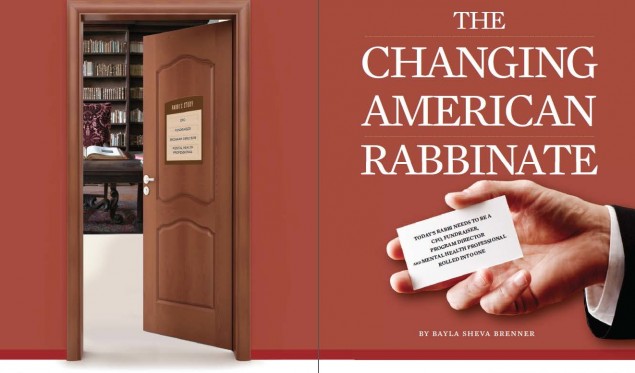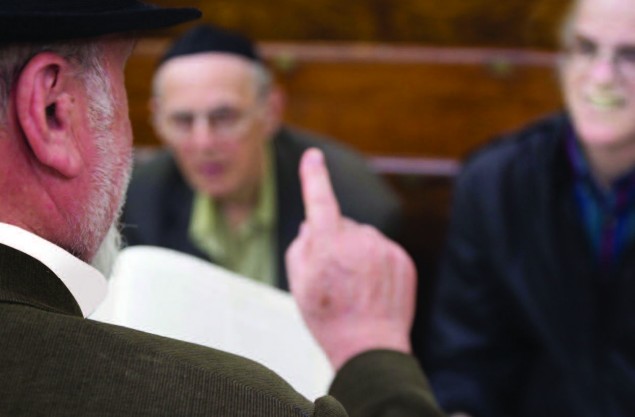Today’s rabbi needs to be a CFO, fundraiser, program director and mental health professional rolled into one
A strong cup of coffee in hand, he stares at the computer screen, putting the final touches on his Shabbat derashah. He then reviews the latest building campaign spreadsheet, adds the name of an addiction specialist to his psychologist referral list, calls a colleague to secure his scholar-in-residence for next month and starts to prepare for the next day’s daf yomi shiur. He’s got five minutes to catch up on the backlog of e-mail she’eilot before his nine o’clock marriage-counseling appointment.
Welcome to the 2013 American rabbinate!
“I had this great passion for working with the klal,” says Rabbi Adir Posy, thirty-two, assistant director of the Orthodox Union’s West Coast Region and associate rabbi at Beth Jacob Congregation in Beverly Hills, California. “So I asked every pulpit rabbi I knew what they hated about the job. I figured if I could deal with all those aspects, then this might be the job for me.” He quickly discovered that he would have to master the art of juggling. “You’re wrapping up a four-million-dollar building campaign Friday morning and pouring kiddush for the kids in shul Friday night. I was sold.”
It wasn’t always this way.
“I’ve watched the rabbinate gather tasks over the years,” says Rabbi Jonathan Rosenblatt, rabbi of the Riverdale Jewish Center for close to three decades. “The [current] level of administrative and entrepreneurial work, counseling, personal service and availability didn’t exist before. My grandfather, who was a very active rabbi, spoke on Shabbat morning at only one minyan; he gave a class Shabbat afternoon and maybe once during the week. I’m basically on [duty] twenty-four/seven.”
According to Marc Rohatiner, fifty-nine, past president of Beth Jacob Congregation and member of three of the shul’s rabbinic search committees, the multitasking rabbi/CEO is what communities have come to expect. “Twenty-five years ago the most important things to ask were what kind of educator would the rabbi be, what kind of speaker and community builder,” he says. “The concept of having someone with administrative skills has become much more front and center. We look for a rabbi who can catch the attention of the community by creating innovative programming. That he can give great derashot—only rarely will a shul say that’s all they are looking for.”
Snappier programming and a growing membership require more capital. Many shuls find they can no longer depend solely on membership dues and annual dinners to satisfy swelling budgets.
Add CFO to today’s rabbi’s skill set.
Aware of the rabbi’s expanded role, many rabbinic hopefuls earn an MBA along with their semichah. “You could have a shul that serves myriad areas of the community with a multi-million dollar budget,” says Rabbi Posy, who came to the rabbinate with a graduate degree in nonprofit management. “The advice I got was not to get an extended psychology degree,” he says.
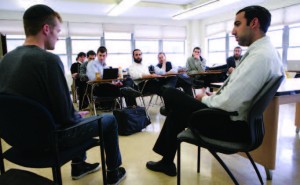
Yeshiva University’s rabbinic training program enlists professional actors to simulate real-life situations that a future rabbi may face over the course of his career.
Photo courtesy of Yeshiva University
Rabbi Shaul Robinson, forty-six, rabbi of Lincoln Square Synagogue on Manhattan’s Upper West Side, sought an MBA in order to further his rabbinic career, assuming “it would make him more effective.” He was right.
Eight years ago, the 700-member shul hired him while contemplating the need to move out of its increasingly cramped quarters. The completed project cost more than fifty million dollars. It took a lot more time and money than anyone expected, says Rabbi Robinson, who is originally from Scotland and served as a rabbi in the UK. In fact, the new shul’s construction came to an abrupt standstill three years ago. “We were on the verge of bankruptcy,” says Rabbi Robinson. “We worked hard to pull it back from the brink.”
Even during that hectic period, Rabbi Robinson viewed his “number-one duty” as being “the rabbi” to his congregants. “When I first interviewed for the position, I made it clear that I was prepared to raise money, but I wouldn’t become a rabbi just to those who could give money,” says Rabbi Robinson. “No matter how much he is expected to excel at fulfilling the fundraiser role, a rabbi cannot fail at being there for each congregant’s spiritual and pastoral needs. People and the leadership of the shul want the rabbi to wear all sorts of hats, but at the end of the day, they want him to be the rabbi.”
Training the Super Rabbi
Rabbinical training programs across the Orthodox spectrum prepare young men heading for the pulpit. I recently visited Yeshiva University’s Rabbi Isaac Elchanan Theological Seminary (RIETS), which brings in seasoned mental health, public speaking and business professionals to impart their expertise.
“We’re trying to be as cutting-edge as we can,” says Rabbi Marc Penner, forty-three, acting dean of RIETS and rabbi for seventeen years at Young Israel of Holliswood in Queens, New York. “I see a tremendous difference from the time they [rabbinical students] first come in to when they get semichah, in terms of their emotional intelligence and ability to speak and relate to an audience with sophistication. They are getting what a rabbi ten years in the rabbinate would have had to figure out for himself. I wish I had had that level of experience when I got semichah in 1995.”
According to Rabbi Penner, along with the rabbi’s Torah and business acumen, congregants are also counting on his psychological insight. “There are a huge number of issues they will be facing; it could be shocking at times for them,” he says. “Whether it’s dealing with homosexuality, Internet addiction, marital infidelity, domestic abuse or mental illness, we want to make sure that their first encounter with issues plaguing the community happens in the classroom and not in their offices.”
People and the leadership of the shul want the rabbi to wear all sorts of hats, but at the end of the day, they want him to be the rabbi.
To that end, RIETS enlisted Professional Actors Training and Helping, an agency that provides professional actors to simulate real-life encounters—in this case, situations a future rabbi may face. Noted psychologists Dr. David Pelcovitz and Dr. Norman Blumenthal prep the actors with possible scenarios that rabbis may struggle with in the course of their careers. “At first, [the potential situations] feel very scary for the students,” says Dr. Pelcovitz. “By the end of the role-playing classes, however, they feel less intimidated.”
RIETS also calls upon experts to speak to the class about domestic violence, infertility, congregants with disabilities and what Dr. Pelcovitz calls “uneven religious change,” that is, cases where a son or daughter leaves Yiddishkeit, or one spouse becomes a ba’al teshuvah and the other doesn’t.
Dr. Pelcovitz notes that the rise in the divorce rate and number of broken engagements in the Orthodox community has necessitated that rabbinical students receive basic training in pre-marital counseling and in working alongside a marital therapist. “These issues are now much more important for rabbis to understand, and to know how to intervene in an effective way,” says Dr. Pelcovitz. “These skills have become part of the rabbi’s job description.”
Rabbi in a Tech-Savvy World
The technological revolution is a definite life changer for congregants and a significant game changer for today’s rabbis.
“Any new technology comes with blessings and challenges,” says Rabbi Dr. Jacob J. Schacter, university professor of Jewish history and Jewish thought at YU and senior scholar, YU’s Center for the Jewish Future. A leading Modern Orthodox rabbi, Rabbi Schacter previously served as rabbi of the Jewish Center in New York City for nineteen years. He also served as dean of the Rabbi Joseph B. Soloveitchik Institute in Boston, and rabbi of the Maimonides Minyan in Brookline, Massachusetts. “Because it brings the broader culture into the Orthodox home, we are exposed to trends, ideas, images and perspectives of which we never had any awareness before. It also allows rabbis to be in touch with congregants, communicating with them on Twitter, and it has created a tremendous opportunity to disseminate Torah. If you go onto the web sites of major Modern Orthodox shuls, you’ll see that the rabbi’s [Shabbat] sermon has already been posted by Sunday morning.”
Yet rabbis lament that members of the community find it unnecessary to actually come and sit through their shiurim when they could just download them and listen in the car. “If you don’t attend a shiur in person, you can’t ask questions,” says Rabbi Steven Pruzansky, rabbi of Bnai Yeshurun in Teaneck, New Jersey, for close to two decades. “You can’t pick up the nuances or fully comprehend what the rabbi is saying when you don’t see his facial expressions; you can’t tell what he is emphasizing, and the context in which it is being said.”
The onslaught of hi-tech stimuli has prompted rabbis to crank up their oratory skills. “They’ve got to be excellent and relevant presenters,” says Rabbi Penner. “[At YU] we do public speaking as an art form.” The YU program includes courses on delivering shiurim and derashot, taught by experienced rabbis in the field. We explain that if you give a boring devar Torah, the audience may not think it’s you, but the Torah. You don’t have the right to give a poor speech; you’re literally a salesman for Torah.”
Rabbi Moshe Hauer, rabbi of Bnai Jacob Shaarei Zion Congregation in Baltimore, Maryland, for the past nineteen years, often addresses the dangers of new technology from the pulpit. “It has had a significant impact on Jewish families,” he says. “In every section of the community there are increased incidents of different forms of infidelity—virtual and actual. My goal is to motivate people to carefully consider the [technological] changes that are occurring, not to simply go with the flow. The rabbi has to inspire and create a connection to Torah and Jewish thought in a way that gives them life in a real way, in terms of understanding themselves and the challenges in their lives.”
Substance Meets Charisma
Apparently, an exuberant, eloquent rabbi with a knack for numbers, knowledge of the latest technology and training in psychoanalysis isn’t enough. Above all, he’s got to know Torah. “If a rabbi comes to any shul across the United States—whether it’s to the left, right or center—and is not equipped in terms of Jewish scholarship, he won’t get to first base,” says Rabbi Dr. Tzvi Hersh Weinreb, executive vice president, emeritus, of the OU, who led Congregation Shomrei Emunah in Baltimore, Maryland, for thirteen years. “Every Orthodox shul out there that has come to me in the past five years for help in its search for a rav asks that the candidate have advanced Torah knowledge, over and above the top members of the shul.”
Rabbi Schacter concurs. “The level of learning among the members of the shul is much higher than it was forty or fifty years ago,” he says. “Today, members of shuls expect their rav to have a greater sophistication than they used to have in terms of Gemara, Rashi, Tosafot and the ability to deliver shiurim and give piskei halachah. Rabbis today deal with congregants who can challenge them in [these areas].”
Yet he can’t invest too much of his time mining the depths of Talmud and Tanach without addressing the issues of the day. “Ba’alei batim want the rabbi to be aware of the world they live in, to read the newspapers they read and be up to date on world events, Israel, trends in the US—the membership’s Shabbat table talk,” says Rabbi Schacter. “And he has to have something thoughtful and Torah-based to say that will help deepen their understanding of these events.”
Rabbi Posy experienced a case in point this past Shavuot. After preparing an erudite shiur for the shul’s all-night programming, he consulted with the senior rabbi. “I realized that maybe it was a phenomenal shiur, but it wasn’t going to be what the community was interested in,” he says. He chose to speak about the implications of the recent kashrut scandal in Los Angeles instead.
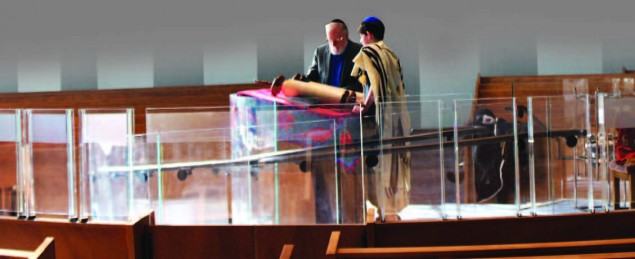
The interior of the new Lincoln Square Synagogue, a fifty-million dollar project.
Photo: Cetra/CRI Architecture PLLC
Burgeoning shuls often spawn multiple minyanim catering to diverse age groups, observance levels and attention spans. Rabbi Rosenblatt calls it “the great boutique.” And the rabbi is the rabbi of all of them. “He’s running to name a baby in one minyan and greeting a chattan in another,” he says. “He needs roller skates.”
The rabbi’s attention to his congregants doesn’t end with the singing of Adon Olam; he’s also expected to make appearances in their lives outside the synagogue walls. “A good rabbi is going to invest a certain number of hours in the day school every week,” says Rabbi Steven Weil, executive vice president of the OU who served as the rabbi of Beth Jacob Congregation in Beverly Hills, California, for nine years. “As a shul rav, I walked the halls of the day schools and high schools, visiting the kids and supporting the schools. I ate in the cafeteria with them and—with the parents’ permission—I took them out for lunch.”
Communities have come to rely on their rabbis to represent them in all places at all times, functioning as their liaisons with the local federations, AIPAC and in the full gamut of communal and civic affairs. In addition, rabbis partner with the lay leadership in creating opportunities for outreach and inreach. “I brought some of the shul’s teens to AIPAC when lobbying at the State House,” says Rabbi Weil. “The senators and congressmen were actually happier to talk to the kids, to hear their take on current issues.”
Shul members’ ever-expanding list of expectations is giving those in charge of rabbinic placement a run for their money. “It’s as difficult as making a shidduch,” says Rabbi Ronald Schwarzberg, director of the Morris and Gertrude Bienenfeld Department of Jewish Career Development and Placement at YU. “With one major difference: the rabbi has to marry an entire kehillah.” To help search committees streamline the process, he sends a forty-page brochure with a comprehensive checklist and timeline. “Each step could take months,” he says. “I always remind them that they are volunteers and they have to try to stick to a time-table in order not to burn themselves out.” He finds that it takes between twelve and eighteen months for a rabbi to find a position.
The Rebbetzin’s Role
The role of the rebbetzin is often a hotly debated topic. “Once upon a time, the rebbetzin was seen as an extension of the rabbi,” says Rabbi Uri Goldstein, rabbi of Congregation Ahavat Achim in Fairlawn, New Jersey, and former assistant rabbi at the Park East Synagogue in New York City. “She was actively involved in the community, coordinated Shabbat meals, bikur cholim—it was more of a maternal role. Today, the wives of rabbis have their own aspirations and careers, their own paths in life. My wife is getting a PhD in Jewish history from NYU; others are doctors, lawyers, psychologists and CEOs. There’s that balance of your life and career and the second career that you’ve married into and don’t get paid for,” says Rabbi Goldstein, who, together with his wife, formerly served as a Jewish Learning Initiative on Campus (JLIC) couple at UCLA in Los Angeles. (JLIC is the OU’s program that places Orthodox rabbinic couples to serve as Torah educators on college campuses.)
Nonetheless, shuls continue to have certain expectations of the rebbetzin. “Although there are still communities where the rabbi’s wife prefers to be a Jewish educator, there are others where she is a professional and functions primarily as ‘the rabbi’s wife,’” says Rabbi Rosenblatt. He stresses that “out-of-town” communities place greater demands on their rebbetzins and interview them as rigorously as they do the rabbis. “My wife, who is an attorney and very respected by our congregation, states her position: ‘You hired my husband, not me.’ Make no mistake, she does a tremendous amount of chesed for others and is personally in touch with many in the community, but she would have done that if her husband was a shoemaker.”
And what about the rabbi’s role at home?
That rabbinic families suffer is not unheard of; marital discord among rabbis is common, says Rabbi Weinreb, who personally counsels rabbis. He recalls one rebbetzin crying in his office because of the many Sunday mornings the family had packed up the car to go on a day trip—then having to cancel due to a congregational crisis. “It’s not easy,” Rabbi Weinreb admits. “As my wife puts it, ‘When you get old, the shul is not going to take care of you. You are going to be long gone as far as they’re concerned.’ It’s your family that matters.”
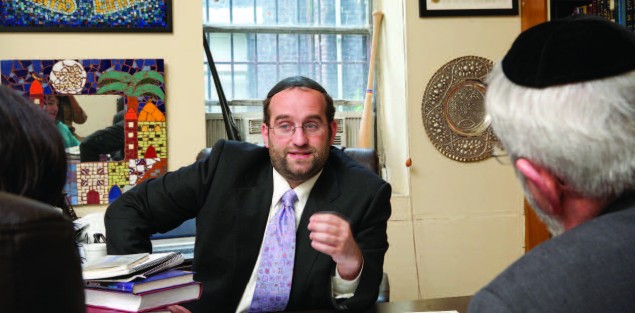
Rabbi Shlomo Einhorn, former rabbi at West Side Institutional Synagogue. He is currently dean and rav of Yeshivat Yavneh in Los Angeles. Photo: Erica Berger
Why It’s All Worth It
One would think that having to play so many roles to so many people would dissuade young men from pursuing the vocation of rabbi. Evidently, the love of Torah and the Jewish people and the call of spiritual leadership make a convincing argument for many idealistic—and determined—rabbinical students.
“My mother thought I would be a lawyer, like my father; I had another perspective,” says Jason Finkelstein, twenty-five, a RIETS student. “You may not make as much money and it’s a difficult lifestyle, but if you believe that the Ribbono Shel Olam gave you the ability to reach others, to learn and spread Torah, then the light at the end of the tunnel is that He gave it to you for a reason and He will help you overcome the obstacles.”
Many longtime rabbis do not regret their career choice. “I am part of every family in the shul,” says Rabbi Pruzansky. “When a family is hit by tragedy, the rabbi feels it every time. It’s especially trying to have to say farewell to a cherished member and friend.”
He frequently passes his hard-won wisdom along at rabbinic seminars. “One of the things I speak about is a piece of paper I constantly carry with me,” he says. “Before a funeral a while back, I took out a piece of paper to record the eulogizers. [Later that day] I was to officiate at a wedding and jotted down who would be getting [to recite the] sheva berachot. When I reached in my pocket for the sheva berachot list, I instead took out the paper with the list of eulogizers. I reached into my pocket again, but there was nothing there. I turned the paper over in my hand and there was the sheva berachot list—it was two sides of the same paper. We’re there for our congregants with joy at their semachot and tears at their moments of grief. The rav has to be 100 percent wherever he is.”
Despite the myriad talents a rabbi needs, what ultimately determines his success is his spiritual leadership.
“The average baalabus today is trying to figure out a way to live with one-and-a-half feet in the broader culture while maintaining an authentic connection to Torah,” says Rabbi Schacter. “It’s the rabbi’s job to mount an argument and make a presentation that will inspire these Jews to deepen their allegiance to and engagement with Torah, mitzvot and HaKadosh Baruch Hu. That takes passion, skills to effectively communicate that passion and the knowledge that what the rabbi has to sell is the greatest product in the world.”
Bayla Sheva Brenner is senior writer in the OU Communications and Marketing Department.
